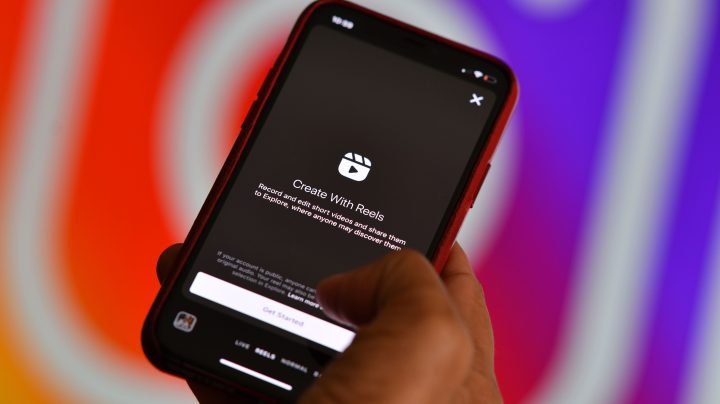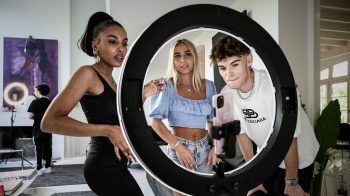
How people are making six figures a year through Instagram Reels
How people are making six figures a year through Instagram Reels

In 2020, Instagram launched Reels, a short-form video feature, in the United States. A year later, the platform started paying creators for the number of views they received through the Reels Play Bonus program. Jacob Sweet noticed a trend: A proliferation of videos showing creators reacting to face filters that randomly generate answers to, well, silly questions. Some were racking up 10 of millions of views. Sweet wrote about it in The New Yorker. He spoke with “Marketplace” host Kai Ryssdal about how creators are making money from the trend. The following is an edited transcript of their conversation.
Kai Ryssdal: Instagram, I can talk about. Instagram Reels, I can talk about. I need to know though, what a face-filter video is.
Jacob Sweet: Yeah, I started seeing these a lot last year. And it can be anything from, you know, a filter that goes over your face that says “What Disney princess are you?” Or “What zodiac sign is your true love?” And then you press a button, and it’ll flash a few options, and then it’ll give you your answer. You know, maybe you’re Snow White. There’s a lot of different kinds of face filters, but the one I was most interested in were these random sort of ones.
Ryssdal: Wow. All right. So we’ll get to the why of it in a minute. But the reason we’re talking to you is that these things get millions and millions of views.
Sweet: Yeah, I just started seeing a lot of them with tens of millions of views, hundreds of millions of views. And often, it was the simplest ones that were getting all these views. It was just “What is my fortune for 2022?” And it’ll say, you know, “Not good.” And it’ll get, you know, 80 million views or something like that. Just things as simple as that. And I just started seeing that all over my timeline.
Ryssdal: OK, the way the internet works is that all of these views translate into dollars. How does that part of this work?
Sweet: Yeah. So in later 2021, Instagram was really trying to compete with TikTok and YouTube. And they opened this program called the Reels Play Bonus, where basically creators would get paid for the amount of views people can get on their videos.
Ryssdal: Like, how much money? Should I think about a career change?
Sweet: Maybe. My mom asked me the same thing when I told her that people were making, you know, $10,000 plus on the app per month. So yeah, I mean, it was a big range of the people I talked to. Some people were making six-figure stuff per year, and some were making, you know, a few thousand.
Ryssdal: OK, so this is gonna sound pejorative, but it’s really not. These things are silly, is a polite way to put it — even the people who do them think they’re silly. Why do you think they’re so spectacularly successful?
Sweet: I think that it is a really short-form video, so it gets this really good replay value. Also, you know, inherently, it has a really appealing format. You get on, it asks you a question, and you might want to wait three or four seconds to see that answer. It’s appealing in that way. And also, Instagram really wanted people to create material from the features that already existed on the site. And the Instagram filters, you know, are made for Instagram specifically. So I think that got a little bit of a boost as well.
Ryssdal: Instagram decided, as you said, that it was worth it to them to pay the money to people to do these face-filter videos to get more people on the platform. And that makes sense, I suppose, to a point. But is there a limit to how long Instagram can keep paying for this stuff and to get more eyeballs?
Sweet: Yeah, it’s hard to tell. I mean, the people I talked to who are making these filters, the most prolific creators, they didn’t really know who was watching their videos. And I think that Instagram, they’re starting to notice that a lot of the comments on these filters are really negative. It’s a lot of people saying, you know, “Please stop showing this on my feed.” “I hate this stuff.” So I do think Instagram’s algorithm is improving over time and that people will and are stopping this. But you know, whenever these new sites are promoting a new feature, there’s always this period of inefficiency where people find this little hack, and they use that to make a lot of money.
Ryssdal: Right. All right, put up or shut up time. Do you spend a lot of time watching these things or what? I mean, like, aside from your professional life — because it’s kind of your job — but in real life?
Sweet: Well, you know, when I was writing this piece, I had to watch quite a lot of them. And kind of the unfortunate thing about reporting on a lot of social media trends is that they see that you’re watching them, and they’re like, you know, “We think you like this. Here’s more and more.” But I don’t watch too many of them. And the funny thing is that a lot of the people that are making them, they don’t watch them either.
There’s a lot happening in the world. Through it all, Marketplace is here for you.
You rely on Marketplace to break down the world’s events and tell you how it affects you in a fact-based, approachable way. We rely on your financial support to keep making that possible.
Your donation today powers the independent journalism that you rely on. For just $5/month, you can help sustain Marketplace so we can keep reporting on the things that matter to you.

















